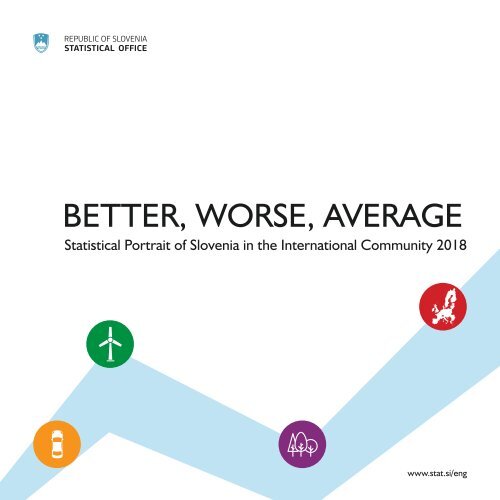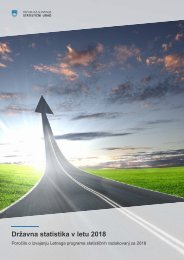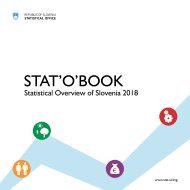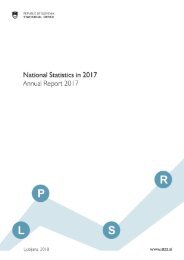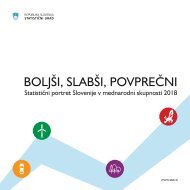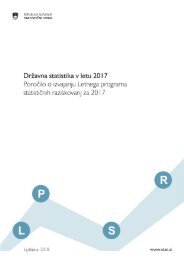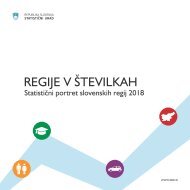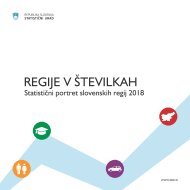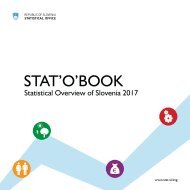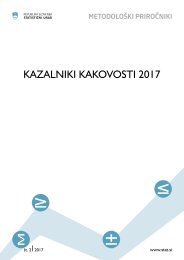Better, worse, average 2018
Create successful ePaper yourself
Turn your PDF publications into a flip-book with our unique Google optimized e-Paper software.
BETTER, WORSE, AVERAGE<br />
Statistical Portrait of Slovenia in the International Community <strong>2018</strong><br />
www.stat.si/eng
<strong>Better</strong>, Worse, Average - Statistical Portrait of Slovenia in the International Community <strong>2018</strong><br />
Original title: Boljši, slabši, povprečni - Statistični portret Slovenije v mednarodni skupnosti <strong>2018</strong><br />
ISSN 2463-7912<br />
Information:<br />
www.stat.si/eng<br />
T: +386 1 241 64 04<br />
E: info.stat@gov.si<br />
@StatSlovenia<br />
@StatSlovenija<br />
Issued and published by the Statistical Office of the Republic of Slovenia, Ljubljana, Litostrojska cesta 54<br />
© SURS – Use of data is allowed provided the source is acknowledged.
BETTER, WORSE, AVERAGE<br />
Statistical Portrait of Slovenia in the International Community <strong>2018</strong><br />
Ljubljana, <strong>2018</strong>
FOREWORD<br />
The Statistical Office prepared a new issue of the publication comparing Slovenia with other EU Member States. The development<br />
of a country and the wider region into which the country is integrated requires integration into international flows. It is therefore<br />
necessary as well as useful to compare oneself with others. But this is not a competition. The publication brings an overview of the<br />
areas in which Slovenia stands out, the areas in which it is <strong>average</strong> and the areas in which it should improve.<br />
We are aware that the volume of data in the world is constantly growing; few people are reading longer texts, visual presentations<br />
are becoming increasingly important. This is why we designed this publication to be visually appealing with the emphasis on<br />
graphical presentations. More data and other material are available on our website and on the website of Eurostat, the statistical<br />
office of the European Union.<br />
Genovefa Ružić<br />
Director-General<br />
3
CONTENTS<br />
3<br />
7<br />
9<br />
12<br />
15<br />
18<br />
21<br />
24<br />
27<br />
30<br />
33<br />
36<br />
39<br />
42<br />
45<br />
FOREWORD<br />
COUNTRY CODES<br />
TERRITORY<br />
POPULATION<br />
EDUCATION<br />
LABOUR, UNEMPLOYMENT AND EARNINGS<br />
QUALITY OF LIFE<br />
ENVIRONMENT AND ENERGY<br />
AGRICULTURE AND FISHERY<br />
GDP AND NATIONAL ACCOUNTS<br />
PRICES AND INFLATION<br />
FOREIGN ECONOMIC RELATIONS<br />
ENTERPRISES, CONSTRUCTION AND INDUSTRY<br />
TOURISM, TRANSPORT AND TRADE<br />
ABBREVIATIONS AND SOURCES
6
AT<br />
BE<br />
BG<br />
CY<br />
CZ<br />
DE<br />
DK<br />
EE<br />
EL<br />
ES<br />
FI<br />
FR<br />
HR<br />
HU<br />
IE<br />
IT<br />
LT<br />
LU<br />
LV<br />
MT<br />
NL<br />
PL<br />
PT<br />
RO<br />
SE<br />
SI<br />
SK<br />
UK<br />
Austria<br />
Belgium<br />
Bulgaria<br />
Cyprus<br />
Czech Republic<br />
Germany<br />
Denmark<br />
Estonia<br />
Greece<br />
Spain<br />
Finland<br />
France<br />
Croatia<br />
Hungary<br />
Ireland<br />
Italy<br />
Lithuania<br />
Luxembourg<br />
Latvia<br />
Malta<br />
Netherlands<br />
Poland<br />
Portugal<br />
Romania<br />
Sweden<br />
Slovenia<br />
Slovakia<br />
United Kingdom<br />
country codes<br />
V nekaterih grafikonih in infografikah prikazujemo podatke “po izbranih državah”: gre za primerjavo Slovenije z državami, ki glede na vrednost<br />
kazalnika, ki ga prikazujemo, izstopajo navzgor ali navzdol. Kjer je mogoče, prikažemo tudi vrednost povprečja za EU-28.<br />
7
TERRITORY<br />
9–11<br />
633,000<br />
square kilometres is the area of France, the<br />
largest EU Member State.<br />
1958<br />
is when Belgium, France, Germany, Italy,<br />
Luxembourg and the Netherlands established<br />
a community that later became the EU.<br />
315<br />
square kilometres is the area of Malta, the<br />
smallest EU Member State.<br />
38<br />
percent of Slovenia’s area was protected for<br />
biodiversity in 2016 (largest in the EU).<br />
1,450<br />
people per square kilometre was the<br />
population density in Malta in 2016 (largest<br />
in the EU).<br />
70<br />
percent was the share of forest area in<br />
Sweden in 2015 (largest in the EU).<br />
9
Year of EU accession<br />
CY<br />
CZ<br />
EE<br />
HU<br />
BE<br />
LV<br />
FR<br />
LT<br />
DE<br />
MT<br />
IT<br />
DK<br />
PL<br />
LU<br />
IE<br />
PT<br />
SK<br />
NL<br />
UK<br />
ES<br />
SI<br />
HR<br />
1958<br />
1973<br />
1986<br />
2004<br />
2013<br />
year<br />
1980<br />
1950<br />
1960 1970<br />
1990 2000 2010 2020<br />
1981<br />
1995<br />
2007<br />
EL<br />
AT<br />
FI<br />
SE<br />
BG<br />
RO<br />
AT<br />
Austria<br />
EE<br />
Estonia<br />
IE<br />
Ireland<br />
PL<br />
Poland<br />
BE<br />
Belgium<br />
EL<br />
Greece<br />
IT<br />
Italy<br />
PT<br />
Portugal<br />
BG<br />
Bulgaria<br />
ES<br />
Spain<br />
LT<br />
Lithuania<br />
RO<br />
Romania<br />
CY<br />
Cyprus<br />
FI<br />
Finland<br />
LU<br />
Luxembourg<br />
SE<br />
Sweden<br />
CZ<br />
Czech Republic<br />
FR<br />
France<br />
LV<br />
Latvia<br />
SI<br />
Slovenia<br />
DE<br />
Germany<br />
HR<br />
Croatia<br />
MT<br />
Malta<br />
SK<br />
Slovakia<br />
DK<br />
Denmark<br />
HU<br />
Hungary<br />
NL<br />
Netherlands<br />
UK<br />
United Kingdom<br />
Source: https://europa.eu/european-union/index_en, 27. 2. 2017<br />
© SURS<br />
10
Population density in EU-28 Member States, 2016<br />
Source: Eurostat (http://ec.europa.eu/eurostat, 24. 4. <strong>2018</strong>)<br />
© SURS<br />
11
POPULATION<br />
12–14<br />
512<br />
million was the EU population in 2017.<br />
5<br />
percent more women than men were living in<br />
the EU in 2017.<br />
83<br />
million people were living in Germany, the<br />
most populous Member State, in 2017.<br />
26<br />
years was the <strong>average</strong> age at which young<br />
people in the EU left their parents’ homes in<br />
2017.<br />
460,000<br />
people were living in Malta, the least<br />
populous Member State, in 2017.<br />
81<br />
years is <strong>average</strong> life expectancy of EU<br />
citizens born in 2016.<br />
12
Population in EU-28 Member States, 2017<br />
DE<br />
FR<br />
UK<br />
IT<br />
ES<br />
PL<br />
RO<br />
NL<br />
BE<br />
EL<br />
CZ<br />
PT<br />
SE<br />
HU<br />
AT<br />
BG<br />
DK<br />
FI<br />
SK<br />
IE<br />
HR<br />
LT<br />
SI<br />
LV<br />
EE<br />
CY<br />
LU<br />
MT<br />
mio.<br />
82.5<br />
67.0<br />
65.8<br />
60.6<br />
46.5<br />
38.0<br />
19.6<br />
17.1<br />
11.4<br />
10.8<br />
10.6<br />
10.3<br />
10.0<br />
9.8<br />
8.8<br />
7.1<br />
5.7<br />
5.5<br />
5.4<br />
4.8<br />
4.2<br />
2.8<br />
2.1<br />
2.0<br />
1.3<br />
0.9<br />
0.6<br />
0.5<br />
European Union<br />
511.5 mio.<br />
residents<br />
Source: Eurostat (http://ec.europa.eu/eurostat, 21. 3. <strong>2018</strong>)<br />
© SURS<br />
13
EU-28 population by age groups, 2017<br />
Slovenia’s population by age groups and sex, 2017<br />
Source: Eurostat (http://ec.europa.eu/eurostat, 21. 3. <strong>2018</strong>)<br />
© SURS<br />
14
EDUCATION<br />
15–17<br />
35.4<br />
percent was the share of persons with tertiary<br />
education in Cyprus in 2016 (largest in the<br />
EU).<br />
20.1<br />
percent of young people (15–24 years) in<br />
Italy were not in employment, education or<br />
training in 2017 (most in the EU).<br />
30<br />
percent was the share of adults in Sweden<br />
(25–64 years) participating in education in<br />
2017 (largest in the EU).<br />
95<br />
percent of adults in Lithuania (25–64 years)<br />
had at least upper secondary education in<br />
2017 (most in the EU).<br />
4.6<br />
percent of young people (18–24 years) in<br />
Slovenia with basic education were not<br />
participating in education in 2017.<br />
5.2<br />
percent was the unemployment rate of<br />
persons with tertiary education in Slovenia<br />
in 2017.<br />
15
Residents of EU-28 Member States by educational attainment level, 2016<br />
Source: Eurostat (http://ec.europa.eu/eurostat, 21. 3. <strong>2018</strong>)<br />
© SURS<br />
16
Adults (25–64 years) in EU-28 Member States participating in education and training<br />
(formal or non-formal), 2017<br />
Ten years ago a lower share of adults (9.5%) participated in education and<br />
training (formal or non-formal).<br />
In 2017, 13.5% of adult women and 9.8% of adult men participated in<br />
education and training (formal or non-formal).<br />
Adults (25–64 years) in Slovenia in education and training (formal or non-formal) by sex, 2017<br />
1) Break in time series.<br />
Source: Eurostat (http://ec.europa.eu/eurostat, 22. 3. <strong>2018</strong>)<br />
© SURS<br />
17
LABOUR, UNEMPLOYMENT<br />
AND EARNINGS<br />
18–20<br />
76.9<br />
percent was the employment rate in Sweden<br />
in 2017 (largest in the EU).<br />
49.8<br />
percent of persons in employment in the<br />
Netherlands had part-time employment in<br />
2017 (most in the EU).<br />
43.6<br />
percent was the youth unemployment rate<br />
(15–24 years) in Greece in 2017 (largest in<br />
the EU).<br />
261<br />
euros was the gross minimum wage in<br />
Bulgaria in <strong>2018</strong> (lowest in the EU).<br />
7.6<br />
percent was the overall unemployment rate<br />
in the EU in 2017.<br />
1.999<br />
euros was the gross minimum wage in<br />
Luxembourg in <strong>2018</strong> (highest in the EU).<br />
18
Order of the countries by the unemployment rate from the lowest to the highest, selected EU-28 Member<br />
States, 3 rd quarter 2008 – 3 rd quarter 2017<br />
order of the countries<br />
2008 2009 2010 2011 2012 2013 2014 2015 2016 2017<br />
NL<br />
DK<br />
CY<br />
AT<br />
SI<br />
CZ<br />
BG<br />
RO<br />
LU<br />
FI<br />
SE<br />
LT<br />
MT<br />
UK<br />
IT<br />
EE<br />
PL<br />
EU<br />
FR<br />
HR<br />
DE<br />
IE<br />
EL<br />
LV<br />
BE<br />
HU<br />
PT<br />
SK<br />
ES<br />
1.<br />
2.<br />
3.<br />
4.<br />
5.<br />
6.<br />
7.<br />
8.<br />
9.<br />
10.<br />
11.<br />
12.<br />
13.<br />
14.<br />
15.<br />
16.<br />
17.<br />
18.<br />
19.<br />
20.<br />
21.<br />
22.<br />
23.<br />
24.<br />
25.<br />
26.<br />
27.<br />
28.<br />
29.<br />
countries<br />
1.<br />
2.<br />
3.<br />
4.<br />
5.<br />
6.<br />
7.<br />
8.<br />
9.<br />
10.<br />
11.<br />
12.<br />
13.<br />
14.<br />
15.<br />
16.<br />
17.<br />
18.<br />
19.<br />
20.<br />
21.<br />
22.<br />
23.<br />
24.<br />
25.<br />
26.<br />
27.<br />
28.<br />
29.<br />
CZ<br />
DE<br />
MT<br />
HU<br />
UK<br />
NL<br />
PL<br />
RO<br />
EE<br />
LU<br />
AT<br />
BG<br />
DK<br />
SI<br />
SE<br />
LT<br />
IE<br />
BE<br />
EU<br />
FI<br />
SK<br />
LV<br />
PT<br />
HR<br />
FR<br />
CY<br />
IT<br />
ES<br />
EL<br />
As regards the unemployment rate in the decade under review, Slovenia was<br />
ranked the highest in the 3 rd quarter of 2008 when it had the fifth lowest rate in<br />
the EU (4.1%). A year later it was sixth with 6.2%.<br />
In the 3 rd quarter of 2017 Slovenia was 14th in the EU<br />
with the unemployment rate of 6.3%.<br />
Source: Eurostat (http://ec.europa.eu/eurostat, 4. 5. <strong>2018</strong>)<br />
© SURS<br />
19
Monthly gross minimum wage in EU-28 Member States, 1 January <strong>2018</strong><br />
BG<br />
LT<br />
RO<br />
LV<br />
HU<br />
HR<br />
CZ<br />
SK<br />
EE<br />
PL<br />
PT<br />
EL<br />
MT<br />
SI<br />
ES<br />
UK<br />
DE<br />
FR<br />
BE<br />
NL<br />
IE<br />
LU<br />
261<br />
400<br />
408<br />
430<br />
445<br />
462<br />
478<br />
480<br />
500<br />
503<br />
677<br />
684<br />
748<br />
843<br />
859<br />
1,401<br />
1,498<br />
1,563<br />
1,578<br />
1,614<br />
1,999<br />
0 250 500 750 1,000 1,250 1,500 1,750<br />
2,000<br />
EUR<br />
Source: Eurostat (http://ec.uropa.eu/eurostat, 24. 4. <strong>2018</strong>)<br />
© SURS<br />
In <strong>2018</strong> the gross minimum wage was the lowest in Bulgaria (EUR 261) and the highest in Luxembourg (EUR 1,999). In Slovenia it was EUR 843,<br />
which ranked our country among countries with high minimum wages. The minimum wage is not legally stipulated in all Member States. This is true<br />
of Denmark, Cyprus, Austria, Italy, Finland and Sweden.<br />
20
QUALITY OF LIFE<br />
21–23<br />
25.3<br />
percent of Romania’s population was living<br />
below the at-risk-of-poverty threshold in 2016<br />
(most in the EU).<br />
77<br />
percent of Slovenia’s population (16–74<br />
years) were regular Internet users in 2017.<br />
662<br />
cars per 1,000 population were registered in<br />
Luxembourg in 2016 (most in the EU).<br />
25<br />
percent of households in Bulgaria were<br />
living in areas exposed to crime, violence or<br />
vandalism in 2016 (most in the EU).<br />
510<br />
physicians per 100,000 population were<br />
working in Austria in 2015 (most in the EU).<br />
8<br />
was the <strong>average</strong> mark (on the scale from 0<br />
to 10) given by residents of Denmark and<br />
Sweden in 2013 regarding their general life<br />
satisfaction (the highest in the EU).<br />
21
Number of cars per 1,000 population, selected EU-28 Member States, 2016<br />
1) Data for 2015.<br />
Source: Eurostat (http://ec.europa.eu/eurostat, 26. 3. <strong>2018</strong>)<br />
© SURS<br />
22
Number of physicians per 100,000 population in EU-28 Member States, 2015<br />
The number of physicians in Slovenia is growing; in 2005<br />
it was 235, in 2010 243 and in 2015 283 per 100,000<br />
population. Despite the upward trend, the number of<br />
physicians in Slovenia is among the lowest in the EU-28.<br />
1) Data for 2014.<br />
2) Break in time series.<br />
Source: Eurostat (http://ec.europa.eu/eurostat, 26. 3. <strong>2018</strong>)<br />
© SURS<br />
Most common causes of death, Slovenia, 2016<br />
Sources: SURS, NIJZ<br />
© SURS<br />
23
ENVIRONMENT AND<br />
ENERGY<br />
24–26<br />
100.9<br />
percent was energy dependency in Malta in<br />
2016 (highest in the EU).<br />
66.1<br />
percent of municipal waste generated in<br />
Germany in 2016 was recycled in Germany<br />
(most in the EU).<br />
6.8<br />
percent was energy dependency in Estonia<br />
in 2016 (lowest in the EU).<br />
57.7<br />
percent of municipal waste generated in<br />
Slovenia in 2016 was recycled in Slovenia.<br />
72.6<br />
percent of electricity was obtained from<br />
renewable sources in Austria in 2016 (most<br />
in the EU).<br />
20.5<br />
tons of carbon dioxide per person was<br />
emitted in Luxembourg in 2015 (most in the<br />
EU).<br />
24
Greenhouse gas emissions in tons of CO 2<br />
equivalent per capita, EU-28, 2015<br />
1) Break in time series.<br />
2) Estimate.<br />
3) Provisional data.<br />
Source: Eurostat (http://ec.europa.eu/eurostat, 10. 4. <strong>2018</strong>)<br />
© SURS<br />
25
Energy dependency in EU-28 Member States, 2016<br />
Energy dependency is the ratio of net imports (import<br />
– export) and energy supply at the country level. It<br />
measures a country’s dependence on energy import.<br />
In 2016 energy dependency of Slovenia (48.4%)<br />
was slightly lower than the European <strong>average</strong>,<br />
which means that Slovenia imported almost<br />
half of the energy it consumed. The least<br />
energy dependent EU-28 Member State<br />
was Estonia, which imported only 6.8%<br />
of the energy it consumed. The most<br />
energy dependent Member State was<br />
Malta (100.9%).<br />
Source: Eurostat (http://ec.europa.eu/eurostat, 26. 3. <strong>2018</strong>)<br />
© SURS<br />
26
AGRICULTURE AND<br />
FISHERY<br />
27–29<br />
860,000<br />
tons of fish and other marine animals were<br />
caught in Spain in 2016 (most in the EU).<br />
9.1<br />
percent of agricultural area in Slovenia was<br />
organically farmed in 2016.<br />
146<br />
tons of fish and other marine animals were<br />
caught in Slovenia in 2016.<br />
5.1<br />
billion litres of wine was produced in Italy in<br />
2017 (most in the EU).<br />
21.3<br />
percent of agricultural area in Austria was<br />
organically farmed in 2016.<br />
1,450<br />
litres of cow’s milk per person was purchased<br />
from producers in Ireland in 2016 (most in<br />
the EU).<br />
27
Commercial marine catch of fish and other marine animals in EU-28 Member States, 2016<br />
1) Data for 2015<br />
Source: Eurostat (http://ec.europa.eu/eurostat, 4. 4. <strong>2018</strong>)<br />
© SURS<br />
28
Litres of cow’s milk per person purchased from producers, selected EU-28 Member States, 2016<br />
48 57 74 99 117 278 299 543 628 844 925 1,450<br />
RO EL BG MT HR SI EU 1) EE LU NL DK IE<br />
l/pop.<br />
1) Estimate.<br />
Source: Eurostat (http://ec.europa.eu/eurostat, 27. 3. 2017)<br />
© SURS<br />
29
GDP AND NATIONAL<br />
ACCOUNTS<br />
30–32<br />
92,800<br />
euros was gross domestic product per capita<br />
in Luxembourg in 2017 (highest in the EU).<br />
78.5<br />
percent of gross domestic product was<br />
government debt in Slovenia in 2016.<br />
7,100<br />
euros was gross domestic product per capita<br />
in Bulgaria in 2017 (lowest in the EU).<br />
12.8<br />
percent was the gross household saving rate<br />
in Slovenia in 2016.<br />
180.8<br />
percent of gross domestic product was<br />
government debt in Greece in 2016 (highest<br />
in the EU).<br />
–0.5<br />
percent was the gross household saving<br />
rate in Lithuania in 2016, meaning that<br />
households there were on <strong>average</strong> in debt.<br />
30
Gross domestic product and government debt in EU-28 Member States, 2016<br />
GDP per capita (EUR), 2017<br />
LU<br />
92,800<br />
FI<br />
40,600<br />
ES<br />
25,000<br />
EE<br />
17,500<br />
PL<br />
12,100<br />
IE<br />
61,700<br />
DE<br />
39,500<br />
MT<br />
23,900<br />
EL<br />
16,600<br />
HR<br />
11,700<br />
DK<br />
50,000<br />
BE<br />
38,500<br />
CY<br />
22,400<br />
SK<br />
15,600<br />
RO<br />
9,600<br />
SE<br />
47,400<br />
UK<br />
35,200<br />
SI<br />
21,000<br />
LT<br />
14,800<br />
BG<br />
7,100<br />
NL<br />
42,800<br />
FR<br />
34,100<br />
PT<br />
18,700<br />
LV<br />
13,900<br />
AT<br />
42,000<br />
IT<br />
28,400<br />
CZ<br />
18,100<br />
HU<br />
12,600<br />
Source: Eurostat (http://ec.europa.eu/eurostat, 30. 5. <strong>2018</strong>)<br />
© SURS<br />
31
GDP per capita in purchasing power standards in EU-28 Member States, 2016<br />
2<br />
%<br />
In 2016 people in Luxembourg were able<br />
to afford on <strong>average</strong> 158% more than<br />
people in the EU-28 overall.<br />
In 2016 people in Slovenia could buy on<br />
<strong>average</strong> 17% less goods and services than<br />
people in the EU-28 overall.<br />
Source: Eurostat (http://ec.europa.eu/eurostat, 4. 4. <strong>2018</strong>)<br />
© SURS<br />
32
PRICES AND INFLATION<br />
33–35<br />
4.5<br />
percent inflation was recorded in Estonia in<br />
2017 (highest in the EU).<br />
2.9<br />
percent more expensive than a year before<br />
was food in Slovenia in 2017.<br />
1.4<br />
percent inflation was recorded in Slovenia in<br />
2017.<br />
8<br />
percent more expensive than a year before<br />
were dwellings in Slovenia in 2017.<br />
7.3<br />
percent more expensive than a year before<br />
was food in Latvia in 2017.<br />
24<br />
percent less goods and services (in value<br />
terms) than in the EU overall could be bought<br />
in Slovenia in 2016.<br />
33
Average annual inflation rate (measured by HICP), %, EU-28, 2017<br />
Source: Eurostat (http://ec.europa.eu/eurostat, 5. 4. <strong>2018</strong>)<br />
© SURS<br />
34
Actual individual consumption per capita in purchasing power standards in EU-28 Member States, 2016<br />
Actual individual consumption per capita in purchasing power standards is the most important component of gross domestic<br />
product and reflects the material well-being of the population. It is calculated on the basis of the prices of goods and services<br />
actualy consumed by individuals<br />
In 2016 actual individual consumption per capita in purchasing<br />
power standards in Slovenia lagged behind the EU-28<br />
<strong>average</strong> by 24%. At that time countries with the values closest<br />
to Slovenia’s were Slovakia (76% of the EU-28 <strong>average</strong>),<br />
Poland (74%), Greece (77%) and the Czech Republic (78%).<br />
Source: Eurostat (http://ec.europa.eu/eurostat, 9. 4. <strong>2018</strong>)<br />
© SURS<br />
35
FOREIGN ECONOMIC<br />
RELATIONS<br />
36–38<br />
5.7<br />
billion euros of goods were exported from<br />
Slovenia to Germany (its main trading<br />
partner) in 2017.<br />
1,200<br />
GWh more of electricity was imported than<br />
exported by Slovenia in 2016 (second in the<br />
EU with the most balanced electricity trade).<br />
5.2<br />
billion euros of goods were imported<br />
to Slovenia from Germany in 2017.<br />
76<br />
percent of its total exports in 2017 was<br />
exported by Slovenia to other EU Member<br />
States.<br />
37,000<br />
GWh more of electricity was imported than<br />
exported by Italy in 2016 (most in the EU).<br />
46<br />
percent of its total imports in 2017 was<br />
imported by the Netherlands from other<br />
EU Member States (least in the EU).<br />
36
Export and import, the most important Slovenia’s trade partners among EU-28 Member States, 2017<br />
Source: SURS<br />
© SURS<br />
37
Export and import of goods and services (% of GDP) in EU-28 Member States, 2017<br />
1) Estimate.<br />
2) Provisional data.<br />
Source: Eurostat (http://ec.europa.eu/eurostat, 10. 4. <strong>2018</strong>)<br />
© SURS<br />
38
ENTERPRISES, CONSTRUC-<br />
TION AND INDUSTRY<br />
39–41<br />
17<br />
percent higher than in 2015 was industrial<br />
production in Cyprus in 2017 (largest<br />
increase in the EU).<br />
8<br />
percent of enterprises operating in Slovenia<br />
in 2015 died in 2015.<br />
16<br />
percent higher than in 2015 was industrial<br />
production in Slovenia in 2017.<br />
39<br />
percent higher than in 2015 was the index of<br />
construction put in place in Ireland in 2017<br />
(largest increase in the EU).<br />
11<br />
percent of enterprises operating in Slovenia<br />
in 2015 were born in 2015.<br />
17<br />
percent more building permits were issued in<br />
Slovenia in 2017 than in 2015.<br />
39
Enterprise births and deaths as a share of all enterprises in 2015 1) , EU-28<br />
1) Business activities excluding activities of holding companies.<br />
Source: Eurostat (http://ec.europa.eu/eurostat, 10. 4. <strong>2018</strong>)<br />
© SURS<br />
40
Share of high-growth enterprises among enterprises with at least 10 employees and share of persons<br />
employed in such enterprises, EU-28, 2015<br />
High-growth enterprises<br />
There were 807 high-growth enterprises in Slovenia in 2016, 29% more than in 2015. The number increased mostly on account of the<br />
growth in manufacturing.<br />
Persons employed in high-growth enterprises<br />
High-growth enterprises in Slovenia employed 56,000 persons in 2016, 32% more than in 2015. Most persons were employed by highgrowth<br />
enterprises in manufacturing (24,000 or 43%).<br />
Sources: SURS, Eurostat (http://ec.europa.eu/eurostat, 10. 4. <strong>2018</strong>)<br />
© SURS<br />
41
TOURISM, TRANSPORT<br />
AND TRADE<br />
42–44<br />
71<br />
percent was the bed occupancy rate in<br />
Cyprus in 2016 (highest in the EU).<br />
7.1<br />
million overnight stays were generated by<br />
residents of Slovenia in Croatia in 2016.<br />
12.2<br />
percent higher than in 2015 was retail trade<br />
turnover in Slovenia in 2017.<br />
26<br />
percent of enterprises in Ireland were selling<br />
online in 2017 (largest share in the EU).<br />
14.1<br />
million passengers were transported by<br />
railway in Slovenia in 2015.<br />
16<br />
percent of household expenditure in Slovenia<br />
was spent in 2016 on personal mobility (most<br />
in the EU).<br />
42
Overnights of foreign tourist in Slovenia and overnights of Slovenian residents in selected EU-28<br />
Member States, 2016<br />
Sources: SURS, Eurostat (http://ec.europa.eu/eurostat, 24. 4. <strong>2018</strong>)<br />
© SURS<br />
43
Enterprises selling online, EU-28, 2017<br />
In Slovenia the share of enterprises<br />
selling online is growing: in 2009 they<br />
represented 9%, in 2014 14% and in 2017<br />
20% of enterprises with at least 10 persons<br />
employed. Only five EU Member States had<br />
higher shares of enterprises selling online in<br />
2017.<br />
Source: Eurostat (http://ec.europa.eu/eurostat, 15. 5. <strong>2018</strong>)<br />
© SURS<br />
44
GDP<br />
EU<br />
EU-28<br />
EUR<br />
HICP<br />
NIJZ<br />
SURS<br />
Eurostat<br />
l<br />
mio.<br />
mrd.<br />
pop.<br />
no.<br />
CO 2<br />
GWh<br />
km 2<br />
%<br />
gross domestic product<br />
European Union<br />
28 Member States of the European Union<br />
euro<br />
harmonised index of consumer prices<br />
National Institute of Public Health<br />
Statistical Office of the Republic of Slovenia<br />
Statistical Office of the European Union<br />
litre<br />
million<br />
billion<br />
population<br />
number<br />
carbon dioxide<br />
gigawat hour<br />
square kilometre<br />
percent<br />
ABBREVIATIONS AND SOURCES<br />
Icons for some infographics were obtained from http: http://www.flaticon.com.<br />
Source (if not stated otherwise): Eurostat.<br />
45


